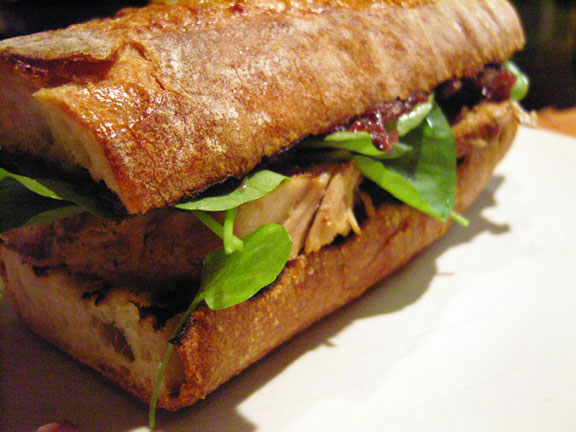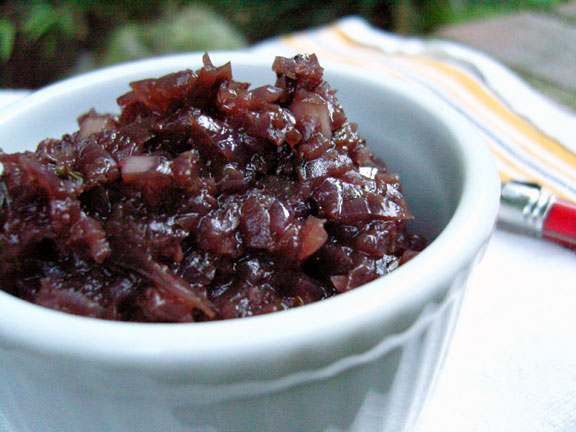 The holiday season is upon us once again, and as always we may be looking for a gift for someone special or a co-worker or boss. This is my attempt at providing some advice for the cooking oriented on the receiving end of those gifts. Some, or maybe most of the books included are from the last couple years. Only a couple are recent releases, but all are books that I value in some particular manner and feel are worthy purchases. Hopefully, you'll agree with me and if you give any as gifts, hopefully, those who receive will find some pleasure in their gift and also come away as a more informed, intelligent cook or food lover.
The holiday season is upon us once again, and as always we may be looking for a gift for someone special or a co-worker or boss. This is my attempt at providing some advice for the cooking oriented on the receiving end of those gifts. Some, or maybe most of the books included are from the last couple years. Only a couple are recent releases, but all are books that I value in some particular manner and feel are worthy purchases. Hopefully, you'll agree with me and if you give any as gifts, hopefully, those who receive will find some pleasure in their gift and also come away as a more informed, intelligent cook or food lover.Eggs - by Michel Roux
The Alpha and Omega of egg cookbooks. Very beautifully photographed, amazingly delicious recipes, helpful techniques, and no shortage of egg wisdom.
The Santa Monica Farmers' Market Cookbook: Seasonal Foods, Simple Recipes and Stories from the Market and Farm - by Amelia Saltsman
Aimed at getting you out to your local farmers' markets wherever you may live. It is full of simple tasty recipes using fresh in-season, locally grown produce, as well as lots of useful information regarding learning the best way to shop farmers' markets. Great book for someone into the local food and slow food movements.
The Improvisational Cook - by Sally Schneider
Extremely well written cookbook that teaches exactly what it's named. She gives a base recipe and then several variations, as well as explaining key ingredients and techniques. This allows you to start thinking outside of the box well beyond her general variations. Great mental value. Helps with ideas for leftovers, and last minute meals based on something you have in the fridge or garden.
Michael Jackson's Great Beers of Belgium - by Michael Jackson
The quintessential book of Belgian beers by the recently deceased, quintessential beer and whiskey writer, Michael Jackson. It's a must have for anyone who fancies themselves a beer drinker as opposed to a oenephile. Actually, anyone who considers themselves a true oenephile should also be well versed in beer. They have common beginnings and it's just recent historical swings in popularity that have created the high-brow wine movement over low-brow beer. But, times are changing and beer is back (it never left) and great hard-to-find beers are easier to procure than ever before. Belgium is quite arguably the most beer prolific country there is. They produce more interesting, finely crafted beers than any other country in the world. If you are interested in discovering beers in the slightest bit, this is a great guide for you to learn from and use as a buying guide. The beer and whiskey world, and the world in general will greatly miss the tremendous palate and easy writing style of Mr. Jackson.
The United States of Arugula - by David Kamp
A very interesting informative look at how we came to be the gourmet eaters that we are. I couldn't put it down and ripped right through it. Covers James Beard, Chez Panisse, Dean & Deluca, etc. Any true foodie would enjoy this book.
Imbibe!: From Absinthe Cocktail to Whiskey Smash, a Salute in Stories and Drinks to "Professor" Jerry Thomas, Pioneer of the American Bar. - by David Wondrich
With the resurgence of the popularity of the classic cocktail, this completely informative, highly entertaining book offers 100 classic cocktails along with some new drinks that pay tribute to the original era of the cocktail. Delicious cocktails that will make you forget the tired over-sweetened frat rock trash that bars have been forcing on you for the past 2 decades. It's about time that you can want to enjoy a refined cocktail that will properly accompany your meal and have a bartender that can actually deliver it. This is for all the drinkers that recognize that a martini is made with gin and not vodka. Vodka is a product that didn't gain popularity in America till after the cold war. Let's get back to our roots and enjoy a proper cocktail made the authentic way. Let's also remember to do it with restraint, as always.
The River Cottage Meat Book - by Hugh Fearnley-Whittingstall
This book is beautiful and a well introduced viewpoint on the respectful handling and consuming of meat. Hugh raises animals himself and the book covers the raising/production, slaughter, and packaging of meat in a earnest thoughtful manner. It makes you consider the animals and the sacrifice that they make so that you can consume their meat. It's a perfect book for someone who is a conflicted meat eater and it's a good companion cookbook to Omnivore's Dilemma. Wonderful rustic recipes and vibrant photographs.
The Silver Spoon - by Phaidon Press
Supposedly, Italy's best-selling cookbook for the last fifty years. It's also billed as the "one" cookbook that every Italian passes onto their children and an obvious gift for Italian brides. It is a mammoth volume of what seems like thousands of recipes, and everyone I've tried has been wonderful. Most recipes are simple succinct and not too time consuming. Perfect guide for preparing daily family meals. A must have for any true cooking library.
Molto Italiano: 327 Simple Italian Recipes to Cook at Home - by Mario Batali
Simple, easy to grasp, yet not dumbed down classic Italian recipes by Mario Batali. Probably, my favorite of his books. I find this one a useful addition to my library. Great when I don't have a lot of time and am craving some rustic comforting Italian food. A simple Italian cookbook that's not afraid of anchovies, sardines, salt cod, chicken liver, octopus, fluke, goat, lamb, tripe, and rabbit while still providing the reader with more familiar fare like gnocchi with fresh tomatoes.
Beer and Philosophy: The Unexamined Beer Isn't Worth Drinking (Epicurean Trilogy) - edited by Steven D. Hales, foreward by Michael C. Jackson
For beer geeks and general imbibers, a book that provides an introspective look at everything to do with beer and it's use in society. Perfect for any true beer lover. Great intro by the late whisky & beer writer, Michael Jackson. Reason enough to buy the book.
The Kitchen Diaries: A Year in the Kitchen with Nigel Slater - by Nigel Slater
Exactly what it's called, a year-long food diary from London Observer columnist, Nigel Slater. In a thoughtful, easy reading manner, Slater lists his meals and life happenings as well as original recipes. It's kind of a seasonal guide as well. I turn to it time and time again based on the current date to see what he was eating and how that could influence me to either cook his appropriate recipe or spark an idea for something else. All the recipes I've tried have been very good and very simple. He cooks like a normal person with a normal life and the recipes are inventive and smart; these are not high-end difficult rock star chef recipes. Funny stories, some great tips and overall very entertaining and useful.
What to Drink with What You Eat: The Definitive Guide to Pairing Food with Wine, Beer, Spirits, Coffee, Tea - Even Water - Based on Expert Advice from America's Best Sommeliers - by Andrew Dornenburg, Karen Page and Michael Sofronski
A simple to understand, very in-depth look at the whole rigmarole surrounding pairing food with alcohol and other liquids including water. If you have any interest in this, then get it. Enough said.
Charcuterie: The Craft of Salting, Smoking and Curing - by Michael Ruhlman & Brian Polcyn
I've read a good deal of literature regarding curing meats and by far I have found this to be the easiest to understand and having a large varied volume of good useful recipes. Making homemade sausage is a very rewarding endeavor if you have the guts to just do it. It's actually very simple and the results are so much better than store bought. This book is an excellent jumping off point for someone interested in trying Charcuterie, but the book also includes very difficult, time consuming recipes that require much attention. It's a real book, but because it's so well written it is an easy to understand guide to the techniques of Charcuterie.
Thai Food - by David Thompson
This is a serious comprehensive tome on Thai cooking. It's beautifully photographed and includes historical information on the Thai people, as well as detailed ingredient and technique descriptions. These are authentic, unadapted recipes, sometimes with hard to find ingredients and difficult techniques. It's pretty much the best Thai cookbook out there and it's a huge 672 pages with a gob of recipes. Thompson says it best, "This book does ask for some effort from those who follow its recipes, but I feel that it is one of my responsibilities to encourage and expand the capacities of the cook, rather than succumb to easier options. To do less would be a grave disservice to the modern cook, to those ancient cooks and to good Thai cooking."
The Omnivore's Dilemma: A Natural History of Four Meals - by Michael Pollan
This is a must read for anyone interested in what they are putting into their bodies and the ramifications of that. My favorite book of last year. It still is shaping how I go about living and eating everyday. The book helps you to see the ramifications of every decision that you make regarding purchasing and eating choices. Pollan is an easy to read and understand author. The book is empowering and makes you a more informed human being and that's simply a good thing.
Jamie's Italy - by Jamie Oliver
The Naked Chef goes to Italy and comes up with a really worthwhile genuine slice of Italian everyday family cooking. These are original recipes for the most part based on classic Italian cooking. There was a short TV series that spawned this book and it was highly entertaining. I was excited to get the book after watching the series and I wasn't disappointed in the least. The recipes are accompanied by beautiful photography encompassing both food and Italian everyday life (along the lines of Saveur, but printed on matte paper which softens the feel of the photos.) It feels like an amazing, long, lazy summer vacation.
Everyone, best wishes for a fantastic and enjoyable holiday season.
egg

